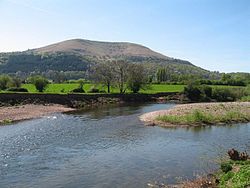Difference between revisions of "Marches Way"
(Created page with "{{county|Chester}} The trail follows the River Usk near Abergavenny The '''Marches Way''' is a partially waymarked long-distance f...") |
m |
||
| Line 4: | Line 4: | ||
==The route== | ==The route== | ||
| − | The route starts at Chester at Chester railway station and then follows the valley of the [[River Dee]] | + | The route starts at Chester at Chester railway station and then follows the valley of the [[River Dee]] southwards before turning east into [[Malpas, Cheshire]] and down to [[Whitchurch, Shropshire]] before roughly following the B5476 road south to [[Shrewsbury]] via [[Wem]]. Once past Shrewsbury, the path scales the [[Long Mynd]] before entering [[Church Stretton]] and the [[Wenlock Edge]] before entering [[Craven Arms]], where one has excellent views of [[Flounder's Folly]]. The path then passes [[Stokesay Castle]] as it heads towards [[Ludlow]]. From Ludlow the route winds through the [[Mortimer Forest]] as it heads towards [[Leominster]]. From here the path climbs [[Dinmore Hill]], crossing the A49 road as it navigates towards [[Hereford]]. The path passes through the city centre of Hereford, picking up the [[River Wye]] before heading towards [[Abbey Dore]] and [[Abergavenny]] where the path skirts the outer edge of the [[Brecon Beacons]] National Park, climbing and running along the ridge of the [[Skirrid]] mountain. The way then follows the [[Monmouthshire and Brecon Canal]] to [[Pontypool]] before heading towards [[Caerleon]] and [[Newport, Monmouthshire|Newport]] via the Llandegfedd Reservoir. The path then heads towards its end point at Cardiff Central railway station via Caerphilly Common and [[Castell Coch]] at [[Tongwynlais]]. |
| − | It links many of the most important historic sites | + | It links many of the most important historic sites in the Marches, drawing together the history from Roman times, passing through two important Roman forts (Isca Augusta and Burrium), and the turbulent mediæval periods when the border lands were contentious power bases vied over by Marcher Lords, Welsh princes and the scenes of rebellions, bloodletting and political power-broking by many of the regions historical characters. |
The terrain of the footpath varies greatly as it proceeds from Chester to Cardiff, passing through the flat [[Cheshire Plain]] to the steep [[Shropshire Hills]] and the mountains of South Wales. The path passes through many woods, forests, river banks and farmland along its journey. | The terrain of the footpath varies greatly as it proceeds from Chester to Cardiff, passing through the flat [[Cheshire Plain]] to the steep [[Shropshire Hills]] and the mountains of South Wales. The path passes through many woods, forests, river banks and farmland along its journey. | ||
Latest revision as of 17:46, 17 March 2021
The Marches Way is a partially waymarked long-distance footpath that runs 218 miles through the Welsh Marches, linking the cities of Chester and Cardiff.
The route
The route starts at Chester at Chester railway station and then follows the valley of the River Dee southwards before turning east into Malpas, Cheshire and down to Whitchurch, Shropshire before roughly following the B5476 road south to Shrewsbury via Wem. Once past Shrewsbury, the path scales the Long Mynd before entering Church Stretton and the Wenlock Edge before entering Craven Arms, where one has excellent views of Flounder's Folly. The path then passes Stokesay Castle as it heads towards Ludlow. From Ludlow the route winds through the Mortimer Forest as it heads towards Leominster. From here the path climbs Dinmore Hill, crossing the A49 road as it navigates towards Hereford. The path passes through the city centre of Hereford, picking up the River Wye before heading towards Abbey Dore and Abergavenny where the path skirts the outer edge of the Brecon Beacons National Park, climbing and running along the ridge of the Skirrid mountain. The way then follows the Monmouthshire and Brecon Canal to Pontypool before heading towards Caerleon and Newport via the Llandegfedd Reservoir. The path then heads towards its end point at Cardiff Central railway station via Caerphilly Common and Castell Coch at Tongwynlais.
It links many of the most important historic sites in the Marches, drawing together the history from Roman times, passing through two important Roman forts (Isca Augusta and Burrium), and the turbulent mediæval periods when the border lands were contentious power bases vied over by Marcher Lords, Welsh princes and the scenes of rebellions, bloodletting and political power-broking by many of the regions historical characters.
The terrain of the footpath varies greatly as it proceeds from Chester to Cardiff, passing through the flat Cheshire Plain to the steep Shropshire Hills and the mountains of South Wales. The path passes through many woods, forests, river banks and farmland along its journey.
The route is only waymarked in Cheshire with black and white waymarker discs.[1]
Linked footpaths
The route crosses many different trails along its 218 miles including:
- The North Cheshire Way (Chester Spur) at Chester railway station
- The Baker Way at Chester railway station
- The Sandstone Trail at Tushingham (going past Old St Chad's Chapel)
- The Maelor Way and South Cheshire Way at Grindley Brook
- The Shropshire Way at various points in Shropshire
- The Mortimer Trail in the Mortimer Forest, Herefordshire
- The Black and White Trail at Leominster.[2]
- The Herefordshire Trail at various points in Herefordshire
- The Offa's Dyke Path and the Beacons Way at Pandy
- The Taff Trail at Tongwynlais, Cardiff
References
- ↑ Cheshire local government list of walks
- ↑ "The Marches Way by Les Lumsdon", Sigma Leisure 1992. ISBN 1-85058-269-6
Outside links
- Northern trailhead at Chester: 53°11’49"N, 2°52’48"W
- Southern trailhead at Cardiff: 51°29’6"N, 3°11’2"W
- The Ramblers Association – basic info on the Marches Way
- Photo of the trail near the Old School, Llanhennock, Monmouthshire
- Photo on the bank of the River Dee
